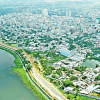Result of govt negligence, inaction
A moderate rain for a couple of hours and much of the capital goes under ankle to knee-deep water. Why?
Urban experts attribute this dire state to the partial or complete destruction of the city's natural drainage network of 46 canals and four rivers, numerous water retention areas such as ponds and ditches, extensive low-lying areas and flood flow zones in the name of development.
The low-lying wetlands and flood flow zones earmarked in the Detailed Area Plan (DAP) have all been filled up, in many cases with government permission, they say.
According to the DAP and the Flood Action Plan, the city should have conserved 5,523 acres of water retention area, 20,093 acres of canals and rivers and 74,598 acres of flood flow zones.
But most of them are gone, thanks to years of negligence and inaction of various government bodies concerned.
As a result, even if there is 50 to 60 millimetres of rain in a day, the Dhaka Wasa pumps cannot drain out the storm water, resulting in the clogging of roads, lanes and by-lanes, said Wasa Managing Director Taqsem A Khan.
So it takes two to three hours to drain out the water, even after the rain stops, he added.
All the 80 water pumps at Rampura, Kamalapur and Kalyanpur pump stations of Dhaka Wasa are working to drain out the accumulated rainwater in the city, but water gets stagnant on the city roads if it rains incessantly.
With its current capacity, Wasa's accumulated pump system can drain out 45 cubic metres of water per second. According to officials, rainfall above 40mm in Dhaka would take at least three hours to recede, as the available pumping facility is capable of draining only 20mm of rainfall.
The Water Development Board has a pump station at Goran Chatbari in Mirpur to drain out storm water.
The delay in pumping out storm water occurs because of slow passage of the water to pump stations, Taqsem said, adding that the slow passage was caused by inadequate capacity of the scanty storm drainage pipelines, severe lack of water retention areas and scanty canals clogged with solid waste.
For immediate remedy, the Wasa chief said, there must be 12 percent of the total city available as rain water retention areas. Also, the remaining canals and storm drainage facility must be cleared and the storm drainage network should be expanded with enhanced capacity.
Visiting Dhanmondi-27, which remained submerged for much of the day, Dhaka South City Corporation Mayor Sayeed Khokon blamed the Dhaka Wasa authorities and the bad drainage system for waterlogging in the capital.
His counterpart in the North Annisul Huq, while visiting waterlogged Kalshi and Sangbadik Khal, said the city's remaining canals and water retention areas were either clogged with solid waste or filled up.
“It is not our duty to clean the clogged canals,” he said, “Wasa has to clean all the remaining canals on an emergency basis, otherwise storm water will not recede fast.”
It may be noted that it is indeed the city corporations' duty to collect the solid waste that clog the canals and storm sewer.
With the canals grabbed and encroached, no one has the magic wands to resolve the storm water problem, and Dhaka mayors have no authority to evict the grabbers, Annisul said. “We will try our best to solve the problem with new drainage project.”
Asked what the government is doing to solve this, local government, rural development and cooperatives Minister Khandker Mosharraf Hossain said it would not recur as the government learned a lesson this year.
“I promise that you will not see these [waterlogging] from next year,” he said, adding that they instructed the Dhaka Wasa to excavate the city's remaining 18 canals immediately.
According to experts, inadequate storm-water drainage system managed by seven different authorities, including private housing developers like Bashundhara, is to blame for taking the Dhaka streets under water every time there is even a moderate rain. There is no coordination among these authorities.
Three organisations -- Rajuk, Wasa and the two city corporations -- have developed the drainage facility in Uttara Model Town.
The storm-water drainage management of the Dhaka-Narayanganj-Demra (DND) and the cantonment areas are being looked after by the Bangladesh Water Development Board and the Cantonment Board respectively.
Dhaka Wasa with 370km storm drainage pipelines covers only one-fifth its service area of 400sqkm, of which some 350sqkm of the surface is paved, preventing the ground percolation of rainwater, said Taqsem.
The Wasa claims the city still has 26 canals, though most of them remain clogged with solid waste.
The two city corporations maintain over 2,000km of feeder drains (open and small diameter pipes) to carry rainwater, and liquid waste from homes into canals and wider diameter storm sewer system, according to Sirajul Islam, chief town planner of Dhaka South City Corporation.

 For all latest news, follow The Daily Star's Google News channel.
For all latest news, follow The Daily Star's Google News channel. 






Comments